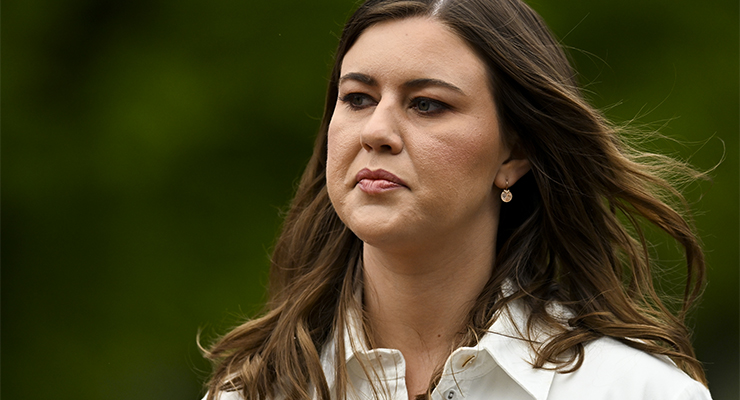
It’s tempting to view the treatment of Brittany Higgins, both within and outside the courts, through the prism of a failed criminal justice system — one that Michael Bradley, who has extensive experience representing survivors, calls “medieval“.
But it’s also useful to view it as part of a single continuum of the exercise of power.
From the moment Higgins went public with her allegations of sexual assault and subsequent treatment by government ministers and staff, she was a direct challenge to the powerful — a challenge that became greater as she, along with a number of other brave women from a variety of backgrounds and for differing causes, became symbols and leaders of a groundswell of anger about gender and workplace issues.
But that deep-seated anger — the fury and dismay of women, and many men, sick of pervasive misogyny, of double standards, of justice systems that treat women and children as second-class citizens, of the casual use of power purely in the interests of privileged males — is no match for a system and institutions built and designed to protect the powerful.
Higgins’ treatment since she emerged in 2021 has been a reaction to the threat she posed, regardless of the merits of her allegations against Bruce Lehrmann, who maintains his innocence. A Coalition politician allegedly linked her drinking with her alleged rape, though he denies having done so. Senator Linda Reynolds, a senior minister and Higgins’ former employer, called her a “lying cow”. The Prime Minister’s Office smeared her partner in background briefings. A sham review was established into who knew about the alleged assault.
That review became the subject of a prime ministerial lie to Parliament. Reynolds’ partner attended the trial, at which the minister was to give evidence, and Reynolds texted suggestions to defence lawyers for Lehrmann. After the director of public prosecutions discontinued the prosecution out of concern for Higgins’ health, an Australian Federal Police source leaked information to News Corp attempting to undermine the prosecution. Today News Corp has continued to try to do so.
That is, it’s not merely the criminal justice system that makes it almost impossible for women to have an allegation of sexual assault successfully prosecuted, or to endure any prosecution without being subjected to ferocious personal attack, but broader systems of power that will work to inflict exemplary punishment on women perceived as a threat.
The office of the prime minister. His department. Journalists and commentators. The AFP. The Coalition’s propaganda unit, News Corp. Coalition backbenchers and ministers.
Each of the perpetrators, from Phil Gaetjens through to Janet Albrechtsen and every politician, staffer, AFP officer and lawyer along the way, is fully culpable for their actions. But they are also part of a systemic response to a perceived threat.
Imagine what a different dynamic might have played out if Higgins had alleged she was assaulted by a staffer from another political party, or if she had alleged she’d been assaulted by a male who could be othered — a person of colour, a welfare recipient, an immigrant. But because she alleged she was sexually assaulted by a Liberal staffer, and Liberal ministers failed in their response because the story she offered discredited the political party in power at the time, she was the target of a systemic response.
Thus the anger at the failure of the criminal justice system to resolve her allegations — to the extent that the criminal justice system can ever resolve such things — and the anger at the behaviour of journalists, MPs and lawyers, is at risk of being misdirected purely at the individuals concerned, when they acted as part of a system of power that worked to protect itself from a threat.
Indigenous communities, and the families of the many hundreds of Indigenous victims of police homicide over decades, have learnt to see the persistent failure of any prosecution of a police officer for homicide as part of a broader system of racial oppression, a continuing legacy of colonialism and dispossession and the self-protective workings of a justice system of which police are an integral part, the failure of “Indigenous policy” devised and delivered by white policymakers and media racism.
Similarly, policymakers have only recently come to understand that domestic violence can only be better addressed through a systemic response that provides far greater support for victims, addresses the economic empowerment of women, focuses more effectively on perpetrators, and recognises embedded misogyny.
In both cases, the long history of justified outrage about individual incidents rarely leads to systemic change, even in the rare event an individual perpetrator is appropriately punished.
In the Higgins case, regardless of the truth of the allegations against Lehrmann, the systemic failings of the criminal justice system formed part of a much greater systemic response directed at punishing and destroying Higgins — one continuing even now.
And for all the anger about her treatment, there is nothing that would stop the same punishment being meted out to another woman perceived as a threat to the powerful.
The systems and networks that delivered it — unaccountable executive government, toxic relationships between a political party and a faux-media outlet, a justice system run by and for lawyers rather than the community — have deeply embedded misogyny within the community, police, courts and the political class.








Crikey is committed to hosting lively discussions. Help us keep the conversation useful, interesting and welcoming. We aim to publish comments quickly in the interest of promoting robust conversation, but we’re a small team and we deploy filters to protect against legal risk. Occasionally your comment may be held up while we review, but we’re working as fast as we can to keep the conversation rolling.
The Crikey comment section is members-only content. Please subscribe to leave a comment.
The Crikey comment section is members-only content. Please login to leave a comment.